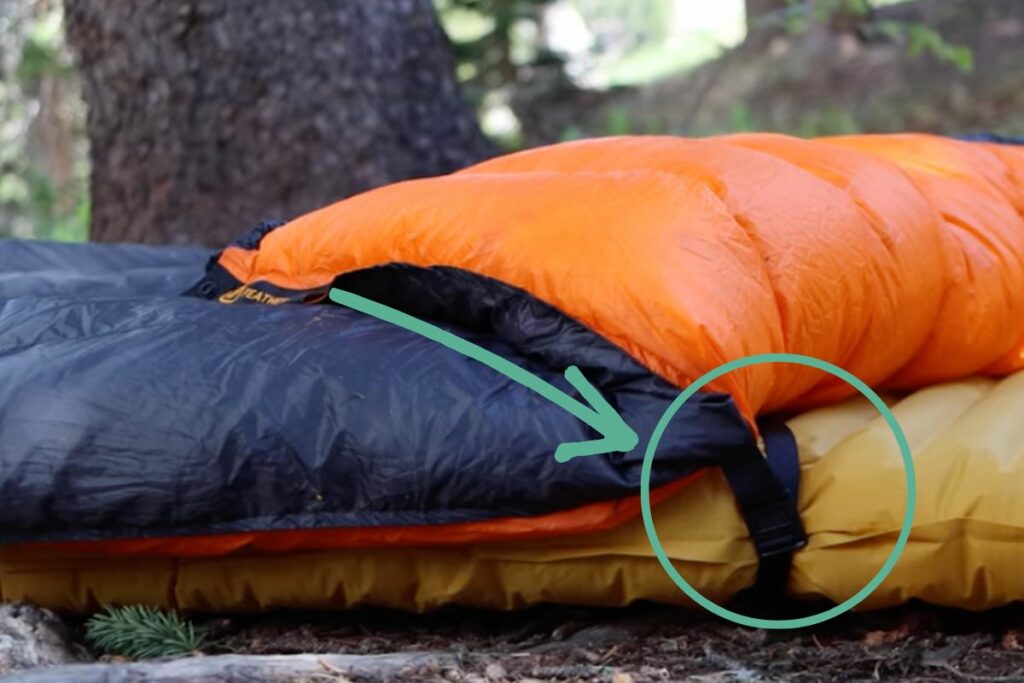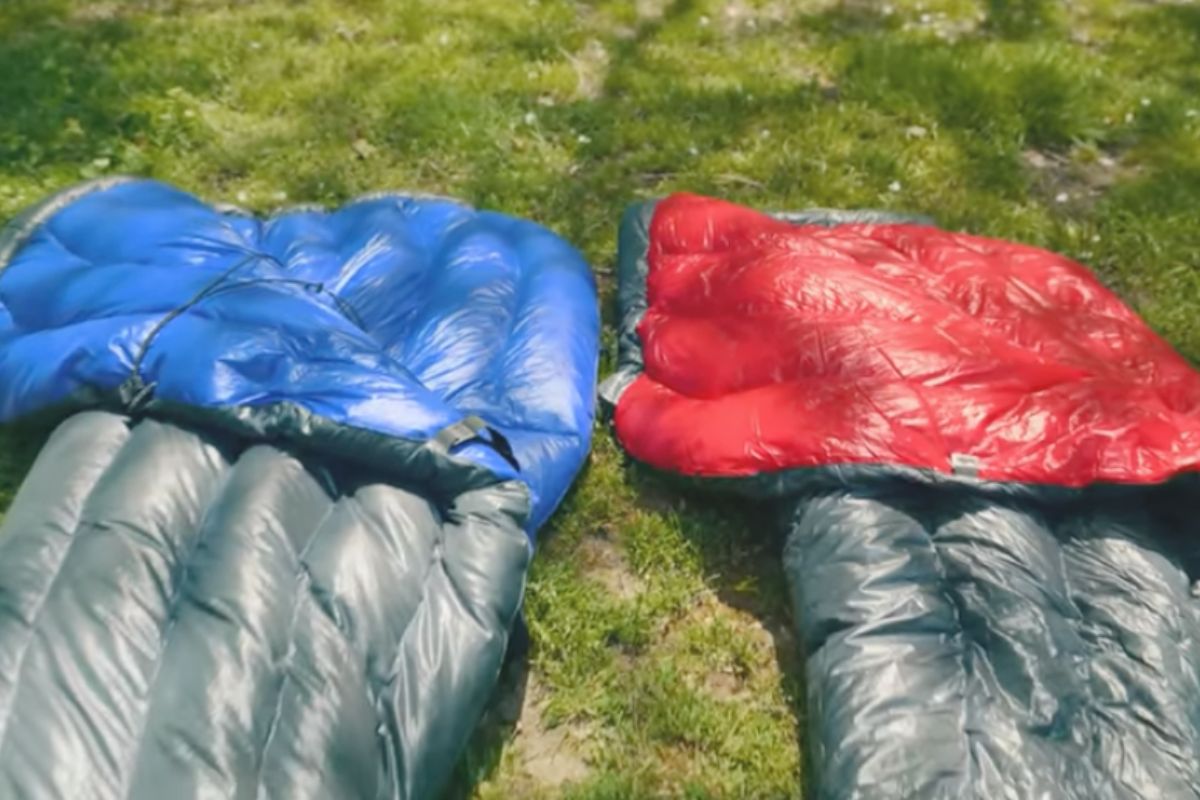Quilts are popular alternatives to sleeping bags, and I’ve spent many nights camping in both of them. While there are many people who take a firm stance in the quilt vs sleeping bag battle I personally think they both have their benefits.
In this blog post, we’ll take a look at the differences between the two, explore their individual pros and cons, discuss when you may want to pick one over the other, and then make our final call on sleeping bags vs quilts.
Let’s dive in!
Table Of Contents
Differences Between Quilts & Sleeping Bags
Quilts and sleeping bags differ in weight, volume/bulk and compressibility, warmth, ease of use, and cost. I’ll go over each aspect and name a “winner” for each feature.
Weight
By far, the single biggest difference between quilts and sleeping bags is their weight, or at least, the typical weight of each. Yes, there are plenty of ultra-light sleeping bags but generally speaking, quilts are lighter. Quilts often weigh less because they don’t need to be made of heavy insulating material, as there are no zippers or hoods that require additional material.
Sleeping bags on the other hand can range anywhere from around 2 to 5 pounds depending upon insulation type and durability of fabric. Therefore if you’re looking for an ultralight sleeping system, a quilt may be a great option for you!
Winner: Quilts
Volume/Bulk And Compressibility
When it comes to volume/bulk and compressibility, quilts win out in a big way. Quilts take up much less space than sleeping bags because they don’t need to fit around your body completely. This means that quilts can easily be compressed down into a small size when not in use which is great for backpackers with limited storage space.
Much like the weight topic, there is no shortage of sleeping bag brands that have ultra-compressible bags that aren’t as bulky as a typical sleeping bag. But I feel confident saying that generally speaking, quilts come with less bulk and are easier to compress.
Winner: Quilts
Warmth
Ok, here is where the claws come out. Proponents of sleeping bags will say quilts simply can’t keep you as warm as a sleeping bag. Whereas quilt loyalists will defend their warm night sleeping in a quilt to their dying day.
Quilt supporters often point out that the bottom layer of a sleeping bag is being crushed by your body weight and thus isn’t providing the loft and insulation that fuels warmth.
That is an accurate point, but that doesn’t necessarily make a quilt warmer. When using a quilt you don’t end up with more insulation above your body, you just eliminate the portion of the sleeping bag that is beneath your body. That doesn’t add warmth, it just eliminates weight.
I will agree that in most weather situations a quilt can keep you as warm as a sleeping bag, but in the most extreme cold conditions, I’m choosing a sleeping bag every time.
Winner: Sleeping Bag
Ease Of Use
This is another battle that has strong opinions on both sides. Defenders of quilts will point say that sleeping bags limit your range of motion at night and many of the designs force to you sleep on your back, which obviously isn’t great for stomach sleepers and side sleepers.
But, sleeping bags are simple to use and intuitive for first-time users. Simply unroll it, climb in, and zip yourself up. Sure, I recommend using an air mattress or cot for comfort, but you don’t have to have one. The bottom of the sleeping bag at least provides a layer of protection between you and the cold ground.
Whereas, with a quilt, there isn’t anything between you and the ground other than maybe the floor of your tent. So a sleeping pad becomes essential, rather than optional. Where the ease-of-use factor comes in, is that for an optimal night’s sleep with a quilt you’ll want to use a strap to attach the quilt to your sleeping pad.
See the image below to see how I connect my quilt to a sleeping pad.

They may not sound challenging, and it isn’t once you get the hang of it. But I can say from first-hand experience that it took me a bit of getting used to and a few nights of trial and error before I got it right. Over time, I’d say both are pretty easy to use, but I give the slight edge to sleeping bags, because I think they are easier to use for first timers.
Winner: Sleeping Bag
Cost
Ready for yet another hot take that I’m sure is going to spark more debate? Most people (and other websites) say that quilts are more expensive than sleeping bags. They aren’t wrong. Most quilts are more expensive than most sleeping bags.
There aren’t many quilts being made for the entry-level campers. The vast majority of quilts are high end products made for serious campers and backpackers looking for camping gear that is as lightweight and compact as possible, while still being warm enough for most situations. As you might expect, premium gear comes with a premium cost.
So sure, quilts are way more expensive than a basic sleeping bag that is bulky and only suited for car camping or other situations where weight and compressibility aren’t factors.
But they aren’t any more expensive than premium sleeping bags that are designed to appeal to the same type of camper. Don’t believe me? Let’s take a look at some real examples:
This 20 F Sleeping Bag by Rab has a price tag of over $700. As the name suggests, it is rated to keep you warm in temperatures as low as 20 degrees Fahrenheit, which is well below freezing. Compare that to the Therm-a-Rest Corus Quilt, which also is rated for 20 degrees Fahrenheit, but costs half as much as the sleeping bag example. I chose those two to illustrate a point. Most of the brands of premium sleeping bags and quilts all fall in the range of $300 – $750.
All that leads me to say that cost isn’t really a factor in the quilt vs sleeping bag debate. Quilts are designed to appeal to a certain type of camper and the sleeping bags that also appeal to that type of camper are comparable in price.
Winner: Draw
When To Choose A Quilt Vs Sleeping Bag
Deciding between a quilt and a sleeping bag largely depends on where and how you plan to camp. Are you staying in a national park lodge or roughing it on a wilderness trip? The situation is what will be the deciding factor.
Backpacking
Backpacking is an activity that requires a lightweight, warm and space-saving sleeping system. Quilts are great for backpacking because they are much lighter than sleeping bags, take up less space in your backpack, and can be easily compressed.
They also offer good temperature regulation and excellent moisture control. On the other hand, sleeping bags may provide more insulation but they are much heavier to carry around and don’t pack down as well as quilts do.
I recommend a quilt for backpacking, but if you choose a lightweight down or synthetic fill bag with excellent compressibility features it might still be an option for backpacking trips.
Hammock Camping
When it comes to hammock camping, a quilt is usually the preferred choice as they are more lightweight and pack down smaller. Due to their lack of zippers or hoods, quilts can be draped over a hammock without getting in the way of your sleeping setup.
Quilts also provide greater flexibility for attaching them to a hammock and for covering yourself at different angles throughout the night. While there are plenty of manufacturers that make sleeping bags for hammocks, I usually opt for a quilt when I’m hammock camping.
Car Camping
When it comes to car camping, a sleeping bag is the traditional and preferred choice. Sleeping bags come in more sizes and shapes than quilts, making them easier to find the perfect fit for you. They also provide extra security with their drawstring hoods so that you’ll stay warm all night long.
Related: Camping Sleeping Bags: My Reviews Of The Top Brands
On the other hand, if you are going car camping on warmer nights, or just want something lighter for your trip, then an ultralight down quilt might be a better option. Quilts generally offer great breathability which can help keep your temperature regulated during warm spells. Plus they tend to be much comfier than sleeping bags due to their roomy construction and lack of zippers or drawstrings.
FAQs
What is the difference between a quilt and a sleeping bag?
A quilt is a blanket with an open back, while a sleeping bag has zippers along the sides which can be zipped all around to keep out cold air. Quilts are typically lighter and more breathable than sleeping bags, making them great for warmer climates or trips where weight is important.
Can you use a quilt for winter camping?
A quilt can be used for winter camping and many avid outdoorsmen prefer quilts no matter the weather. But for extreme cold situations, I recommend a mummy style sleeping bag for maximum warmth and comfort.
What do you put under a quilt for warmth?
When using a camping quilt you’ll definitely need a sleeping pad beneath you for both insulation and comfort. And in some situations like hammock camping, many campers use both a top and bottom quilt for full-body insulation from the cold.
Are quilts better for hot sleepers?
Quilts are better for hot sleepers, and I can say that as a very hot sleeper myself who has spent many warm summer nights camping using both quilts and sleeping bags. The quilt isn’t as restrictive as a sleeping bag and allows for more tossing and turning as well as easier ventilation to release hot air trapped next to your body.
Final Thoughts: Quilt Vs Sleeping Bag
Deciding between a quilt and a sleeping bag, and which one is better for your camping setup depends on your goals and desired level of comfort. Quilts are great for backpacking, as they are lightweight and provide more temperature regulation than sleeping bags.
On the other hand, sleeping bags are a solid choice for car camping or for cold winter conditions. Ultimately, both quilts and sleeping bags have advantages based on size, weight, warmth and ease of use that make them invaluable assets when it comes to outdoor pursuits. So whatever you decide is best suited to meet your needs, you know you won’t be wrong!
Do NOT Overpay For Camping and Outdoor Gear
We Find The Best Deals & Discounts Online And Share Them With YOU

